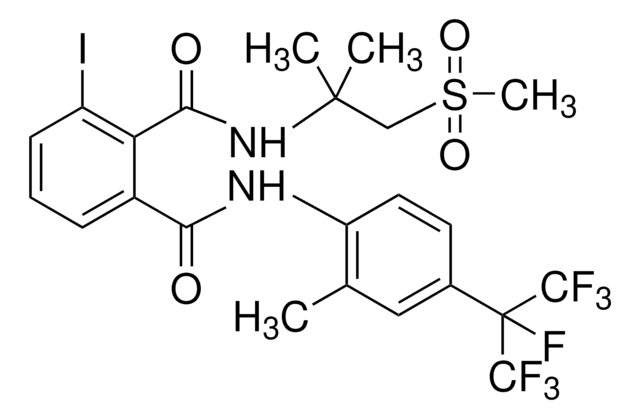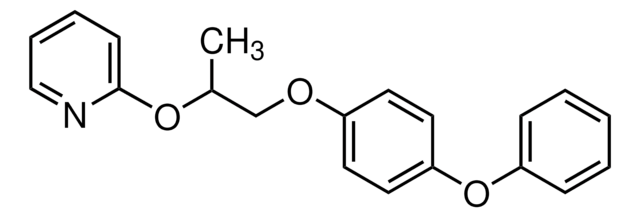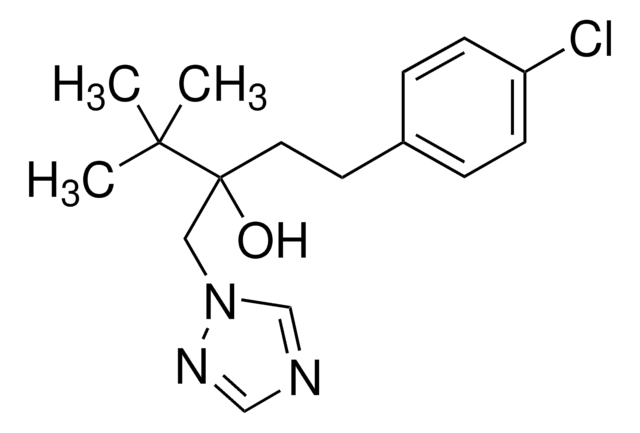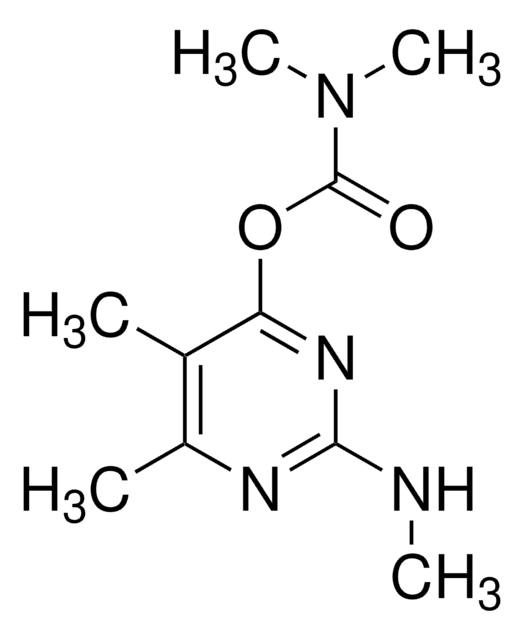32393
Pyridalyl
PESTANAL®, analytical standard
Synonyme(s) :
2-{3-{2,6-Dichloro-4-[(3,3-dichloro-2-propen-1-yl)oxy]phenoxy}propoxy}-5-(trifluoromethyl)pyridine, [2,6-Dichloro-4-(3,3-dichloroallyloxy)phenyl]-3-(5-trifluoromethyl-2-pyridyloxy)propyl ether
About This Item
Produits recommandés
Qualité
analytical standard
Niveau de qualité
Gamme de produits
PESTANAL®
Durée de conservation
limited shelf life, expiry date on the label
Application(s)
agriculture
environmental
Format
neat
Chaîne SMILES
ClC1=C(OCCCOC2=NC=C(C(F)(F)F)C=C2)C(Cl)=CC(OCC=C(Cl)Cl)=C1
InChI
1S/C18H14Cl4F3NO3/c19-13-8-12(27-7-4-15(21)22)9-14(20)17(13)29-6-1-5-28-16-3-2-11(10-26-16)18(23,24)25/h2-4,8-10H,1,5-7H2
Clé InChI
AEHJMNVBLRLZKK-UHFFFAOYSA-N
Vous recherchez des produits similaires ? Visite Guide de comparaison des produits
Description générale
Pyridalyl has to be monitored in the Multiannual Control Programme for Pesticides Residues (MACP), run within the EU and EFTA in/on products of plant origin.
Pyridalyl was approved on 1 July 2014 under the Commission Regulation (EU) No 143/2014/EU as per the Regulation (EC) No 1107/2009 as amended by Commission Implementing Regulations (EU) No 540/2011 and 541/2011. Upon receiving an application to set the new MRLs for pyridalyl from the Evaluating Member State (EMS) following Article 9 of the Regulation on 14 January 2009, EFSA has proposed an MRL of 1 mg/kg for tomatoes, 1 mg/kg for aubergines (eggplants), 2 mg/kg for peppers, 0.2 mg/kg for cucurbits (inedible peel), 3 mg/kg for lettuce, and 0.1 mg/kg for cottonseed.
Application
- To determine the toxicity of pyridalyl on each growth stage of 2 insect pest species and to evaluate its cytotoxicity on the Sf9 insect and CHO-K1 mammalian cell line using the trypan blue exclusion method
- To assess the lethal and sublethal effects of methoxyfenozide and pyridalyl on the larval ectoparasitoid Habrobracon hebetor
- Investigation of the molecular action of Pyridalyl via cytochrome P450 activity using non-selective cytochrome P450 inhibitor, 1-ABT (1-aminobenzotriazole)
- Evaluation of in vitro insecticidal activity of pyridalyl nanosuspension in comparison to technical material and commercial product against tomato fruit and shoot borer (Helicoverpa armigera)
- To elucidate the persistence behavior and risk assessment of pyridalyl in tomato, cabbage, and cultivated field soil over two consecutive seasons
Produits recommandés
Informations légales
Mention d'avertissement
Warning
Mentions de danger
Conseils de prudence
Classification des risques
Aquatic Acute 1 - Aquatic Chronic 1 - Skin Sens. 1
Code de la classe de stockage
10 - Combustible liquids
Classe de danger pour l'eau (WGK)
WGK 3
Point d'éclair (°F)
Not applicable
Point d'éclair (°C)
Not applicable
Faites votre choix parmi les versions les plus récentes :
Déjà en possession de ce produit ?
Retrouvez la documentation relative aux produits que vous avez récemment achetés dans la Bibliothèque de documents.
Notre équipe de scientifiques dispose d'une expérience dans tous les secteurs de la recherche, notamment en sciences de la vie, science des matériaux, synthèse chimique, chromatographie, analyse et dans de nombreux autres domaines..
Contacter notre Service technique










